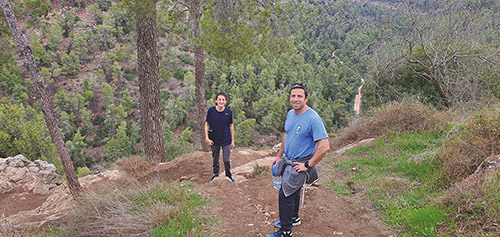
(Courtesy of Judean Journeys) Next week’s fast day, Asara B’Tevet, is not only a fast marking the siege of Yerushalyim by Nevuchadnezar, it is also a general Day of Kaddish for those who have past away with no one to say Kaddish over them. I’d like to introduce a beautiful, less known spot, a place of memory and a wonderful place to hike. It’s likely that you’ve passed the turn off many times when traveling between Yerushalayim and Beit Shemesh.
Tucked away in the Judean Hills near Beit Shemesh, is the Ya’ar HaKedoshim, the Martyr’s Forest. The forest is in a deep valley surrounded by high mountains on each side and these mountains’ slopes were planted on the two banks of the Kisalon River. A thoughtful effort was made by the Israeli government at the time, (the project started in 1946 and dedicated in 1951) together with the Jewish National Fund (KKL-JNF), B’nai Brith and B’nai Brith Women, to diversify the trees planted. You see, Israel’s forests were all set in place. It is very hard for us to imagine this today as we travel on Road 38 and look to our left and right and see all the green. However, this very forest was just rugged stony land, indigenous species were plentiful but non-indigenous trees such as pine, cypress, eucalyptus and carob trees were all planted.
This forest was created to memorialize the six million Jews murdered in the Shoah. Six million were murdered and six million trees were planted. That is why this forest was named the Martyr’s Forest. This site was in fact Israel’s first site of commemoration in 1951, even before Yad Vashem was founded. The diversification of the flora and trees planted was to express the idea that each person was a world destroyed and each came from a different community and country.

If that isn’t moving enough, now think about who it was that worked the land and planted the trees to memorialize their brethren. The KKL-JNF employed new olim who fled Arab countries, olim from all over; from Kurdistan, Morocco, Romania, to Indian Jews. The young struggling State of Israel settled many of these Jews in temporary housing, maabarot, transit camps and later in moshavim for olim. There, a real source of making a living was lacking, as was infrastructure. It was these olim who JNF-KKL hired as day laborers to plant the forests for us to enjoy for generations! Although this was surely very difficult, looking back now, we can see the kibbutz galuyot that took place. It is important to me that we remember this mesirut nefesh as well. These people forested our lands in a period when the area was really frontier, not very populated. More than 10,000 immigrants worked in afforestation at this time, planting a mass of forests in the Judean Hills and up north in the Galil.
We enter the area via the Gate of the Offices that is in honor of the offices and organization of women of B’nai Brith. We continue onto the Cave of B’nai Brith. It is a naturally formed cave on the southern cliff of Nahal Kislaon and is a place of contemplation that was created as a memorial for the Shoah. Nahal Kisalon is one of the longest rivers in the Judean Hills, in our segment along all of the riverbed there are plaques and matzevot, monuments, with the names of communities that were wiped out during the Holocaust.
Right next to the B’nai Brith Cave is a memorial that KKL-JNF inaugurated in 2011 in memory of Anne Frank, with excerpts from her diary. In her diary, Frank describes seeing a chestnut tree through the window of her family’s hideout. The Dutch Jewish artist Piet Cohen’s sculpture here looks like a room that imprisons someone. It represents the room from which Frank could look out and see the tree. Cohen, like Frank, hid as a child during the war. He was hidden in a house in southern Holland and was not discovered.
For our next stop, we can decide whether to climb the steep mountains and hike all the way up to Moshav Kisalon and reach the Scrolls of Fire or to get in the car and drive there. This 26 foot high monument towers above the trees and is one of the most beautiful moving monuments to commemorate the victims of the Holocaust. It was constructed by KKL -JNF in 1968 and it is situated in a location with breathtaking views of the Judean Hills, the Judean Plain and the southern part of the coastal plain.

The monument, shaped like a double Torah scroll, is a large bronze masterpiece, wrought by sculptor Nathan Rapoport. One scroll depicts the destruction of the Jewish people during the time of the Romans and the Holocaust. The other scroll depicts the rebirth—the ingathering of the exiles, the War of Independence, the establishment of the State of Israel and the unification of Jerusalem.
Let us hope and pray that all our tefillot are heard and all our fasts will turn from days of fasting and sadness to days of happiness and meaning.
For more information, visit www.judeanjourneys.com, Judean Journeys on Facebook, or sara_tours__judean__journeys_ on Instagram. To arrange your own Judean Journey, email sara@judeanjourneys.com











